Pitching Mechanics Analysis
Barry Zito
6/14/2008
In a series of articles over at
The Hardball Times, Paul Nyman takes a look at
Barry Zito's pitching mechanics and tries to figure out the root cause
of his recent velocity decline. Here's the money paragraph...
The analysis of Zito can be reduced to one paragraph or less.
Zito pushes the baseball. Zito doesn't know how to throw the
baseball. Never really did and probably never will. He's a
fantastic pitcher who really doesn't know how to throw
efficiently.
I have a couple of problems with what Paul Nyman says in the
paragraph above.
First, saying that Barry Zito pushes the ball is simply
ridiculous. I have worked with many baseball young players. In
fact, I had practice for my Second Grade (8U) boys team last
night. Some of my players do push the ball on occasion. However,
what they do when they push the ball — when they start out
facing the target and basically shot-put it — is completely
different than what Barry Zito does when he throws the ball.
Second, I have spent a significant amount of time looking at Barry
Zito's pitching mechanics and don't find them to be uniquely, or
even particularly, inefficient. For example, Barry Zito doesn't fly open
with his glove like Rich Harden does. Also, rather than having a
possibly less efficient, linear lower body action like Mark Prior, Barry Zito shows
the rotational lower body mechanics that Paul Nyman likes (as do
I) and that you see in pitchers like Greg Maddux and Pedro Martinez.
Has Something Changed?
After checking to see whether a player's pitching mechanics
are inefficient, a second place to look is to see if their
mechanics have changed significantly over time. I did this by
comparing two clips of Barry Zito. The first was from 2004 when
he was throwing 89 MPH and the second was from 2008 when he was
throwing 84 MPH.
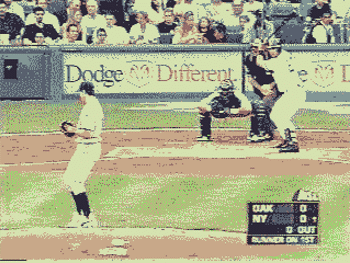
Barry Zito - 2000 and 89MPH
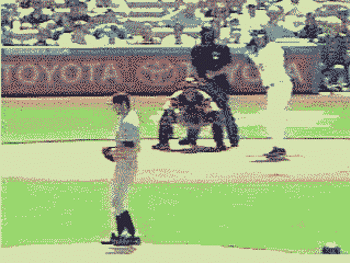
Barry Zito - 2008 and 84MPH
While there are some cosmetic differences between the two
clips, there are no really significant differences. His arm action is
basically the same. So too is his lower body action and timing.
A Subtle Mechanical Flaw?
When you have ruled out inefficient mechanics and changes
over time, the next thing to look for are the telltales of
subtle mechanical flaws.
In my experience, unexplained velocity problems are often a harbinger of
undiagnosed shoulder problems. What happens is that, as the
components of the shoulder (i.e. the muscles of the rotator cuff
and the labrum) degrade, the proprioceptive system detects this
problem and attempts to limit the damage by limiting how hard
the body can perform certain actions. As a result, in pitchers
with worsening shoulder problems, you get a slow and steady
decline in velocity as the proprioceptive system attempts to
limit the damage to the shoulder. Similarly, in pitchers who are coming back
from shoulder surgery, but who have lingering problems, you
often see their velocity plateau at levels below their
pre-surgery values.
The two arm action flaws that can create timing problems
like rushing,
and shoulder problems as a result, are the
Inverted W and the
Inverted L. As it turns out, if you look at clips and stills
of Barry Zito, you can see that he has a significant
Inverted L in his arm action.

Barry Zito's Inverted L
The thing to notice is how Barry Zito's elbow is up at the
level of his shoulders and his forearm is hanging down
vertically beneath it. Just to be clear, making the Inverted L
isn't (that) bad in and of itself. However, it is potentially very bad because it can create a timing problem that, over the years,
can lead to elbow and/or shoulder problems.
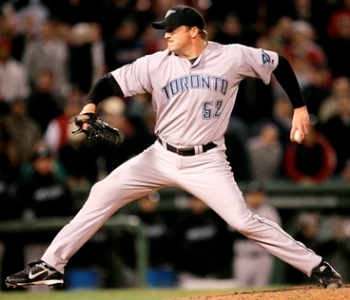
BJ Ryan's Inverted L
It isn't a coincidence that BJ Ryan has a significant Inverted L in his arm action
and has recently had major elbow problems (requiring Tommy John
surgery).
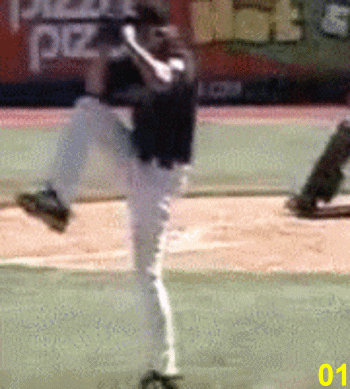
BJ Ryan
As the clip above establishes, BJ Ryan's Inverted L creates
a major timing problem. Notice how his shoulders start rotating
well before his Pitching Arm Side (PAS) forearm is vertical and
in the high-cocked position.
This significantly increases the load on both his elbow and his
shoulder.
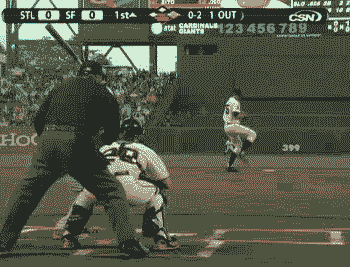
Barry Zito
You can see something similar in the clip above of Barry
Zito. The thing to notice is that his shoulders start rotating
before his PAS forearm is vertical and in the high-cocked
position. Another indication that Barry Zito has a timing
problem, and is
rushing
his throws, is that he leaves the ball up and out of the strike
zone in the clip above. Leaving the ball up is a
classic telltale of a rushing problem.
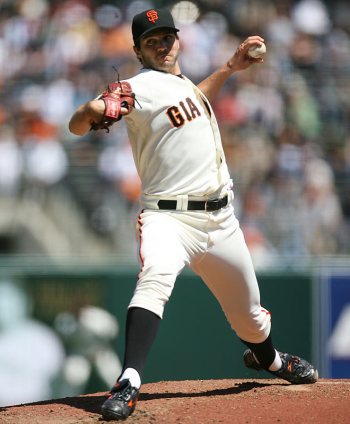
Barry Zito
You can see an indication of Barry Zito's timing problem in
the photo above. The thing to notice is how his PAS forearm is
horizontal at the moment his GS foot plants (and his shoulders
start to rotate). This will increase the force with which, and
the distance over which, his PAS upper arm will externally
rotate and increase the load on his shoulder.
The Bottom Line
I will be the first to admit that Barry Zito's timing problem
isn't nearly as bad as BJ Ryan's. That is why Barry Zito hasn't
yet suffered a catastrophic breakdown. However, I think Barry
Zito's timing problem is significant and makes him a significant
injury risk over the next couple of years.
I also think Barry Zito's timing problem may get worse
as he tries to deal with the problem by adopting some of the
ideas of Momentum Pitching and tries to get more power from his
stride. In my experience, focusing on the stride can easily make
timing problems worse and not better.
|